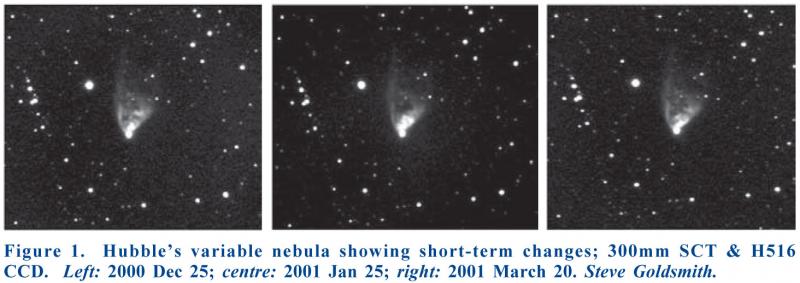A feast of variable nebulae
2018 January 17
 Winter is the season to observe change in a rare group of deep sky objects, the variable nebulae. Suspected variability of several nebulae was a source of study in the mid-nineteenth century with the Great Orion nebula and Merope nebulae, amongst others, thought to change brightness and shape on short timescales. Most were due to varying atmospheric conditions and visual subjectivity of the observer. Photography’s arrival made the study more objective. There is no observable change in Messiers 42 or 45.
Winter is the season to observe change in a rare group of deep sky objects, the variable nebulae. Suspected variability of several nebulae was a source of study in the mid-nineteenth century with the Great Orion nebula and Merope nebulae, amongst others, thought to change brightness and shape on short timescales. Most were due to varying atmospheric conditions and visual subjectivity of the observer. Photography’s arrival made the study more objective. There is no observable change in Messiers 42 or 45.
However, there are now six known nebulae that definitely shape-shift in time, four in the northern hemisphere and two in the southern, the latter not being visible from the United Kingdom. However, throughout winter, the other four are pretty well placed. All are associated with Young Stellar Objects (YSO) and thus also interest variable star observers. These variable stars are unpredictable in both their period and amplitude. The varying shape and brightness of the associated nebulae are endlessly fascinating.
Hubble’s variable nebula
The easiest of the four variable nebulae is that named after Edwin Hubble, NGC 2261 in northern Monoceros, just south of the Christmas Tree cluster (NGC 2264). It is a reasonably bright 2 arcminute fan-shaped flame burning north from the variable star R Monocerotis.
Although known as Hubble’s variable nebula, it was in fact discovered by William Herschel in 1783 and the variability of R Mon noted by Julius Schmidt from Athens observatory in 1861. It gained the Hubble moniker because Edwin Hubble wrote a paper on the variability of the nebula based on photographs taken between 1900 and 1916. Carl Lampland used the 42-inch [1.08m] reflector at Lowell Observatory to photograph the nebula regularly between 1916 and 1951, demonstrating this beyond doubt. It was the first target for the great Hale telescope (the 200-inch [5m] at Mt Palomar) in 1949.
R Mon varies erratically from magnitude 9.5 to 13.0 but precision is difficult as it is cocooned within the nebula itself. The fan varies in shape and brightness over weeks or months, and change can be demonstrated effectively by amateurs… (continued)Login or click above to view the full illustrated article in PDF format)
| The British Astronomical Association supports amateur astronomers around the UK and the rest of the world. Find out more about the BAA or join us. |
